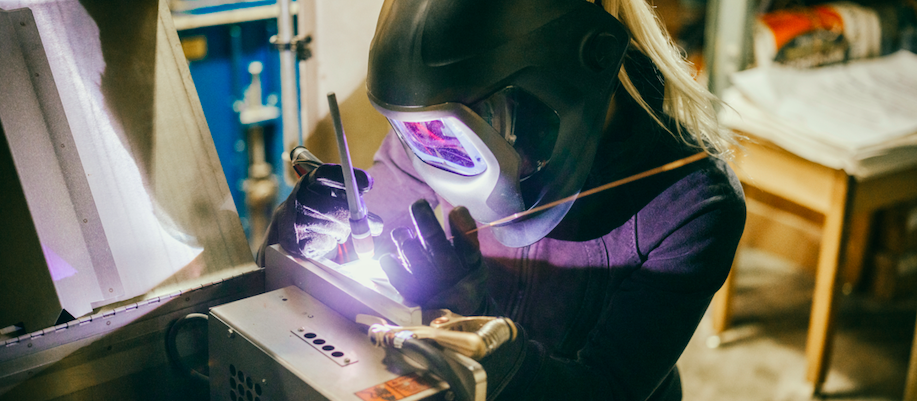Respiratory physician Lutz Beckert considers chronic obstructive pulmonary disease management, including the prevention of COPD, the importance of smoking cessation and pulmonary rehabilitation, and the lifesaving potential of addressing treatable traits. He also discusses the logic of inhaler therapy, moving from single therapy to dual and triple therapy when indicated, as well as other aspects of management
Carcinogenic welding fumes require exposure monitoring and control
Carcinogenic welding fumes require exposure monitoring and control

Here at New Zealand Doctor Rata Aotearoa we are on our summer break! While we're gone, check out Summer Hiatus: Stories we think deserve to be read again! This article was first published on 27 April 2022
Occupational health expert David McBride looks at the hazards of welding, focusing on exposure to fumes that are now known to be carcinogenic to humans
- Since 2018, welding fume has been classified as an IARC Group 1 carcinogen.
- It is important for employers to know the welding electrodes being used so exposure to individual components of the welding fume can be assessed.
- Urinary chromium is a good marker of airborne exposure.
- A good respiratory questionnaire should be used for welders.
This article has been endorsed by the RNZCGP and has been approved for up to 0.25 CME credits for continuing professional development purposes (1 credit per learning hour). To claim your credits, log in to your RNZCGP dashboard to record this activity in the CME component of your CPD programme.
Nurses may also find that reading this article and reflecting on their learning can count as a professional development activity with the Nursing Council of New Zealand (up to 0.25 PD hours).
This month, I thought I would write about the recent WorkSafe Workplace Exposure Standards (WES) review. This occurs each year to make sure the standards for chemical substances in air are at “reasonably safe” levels. Following public consultation, the WorkSafe meeting took place in March, with more than 30 substances on the agenda.
WES values provide the basis for how chemical risk, or indeed any risk, in the workplace should be managed. If the risk cannot be eliminated, then the person in control of the business unit must minimise the risk, and the WES is the management tool. In short, the substance in air must be measured, levels compared with the WES, control measures put in place, and health monitoring instituted, if suitable health monitoring is available.
Many of the chemicals that were up for WES review are esoteric, but welding fume is not – welding is a very common process used throughout New Zealand. The proposed WES change this year came about because the International Agency for Research on Cancer (IARC) published a review in 2018, reclassifying welding fume as a Group 1 carcinogen, which means there is sufficient evidence for human carcinogenicity.1
Welding is used to fuse metals. A welding electrode, through which a high current is passed, is used to strike an arc, raising temperatures to over 4000°C, forming a weld pool, which fuses the base metals being joined.
For lighter welding, in the metal inert gas (MIG) techniques, the welder uses a wire electrode fed through a gun. The inert gas – carbon dioxide or argon – shields the base metal from oxygen and prevents metal oxides being formed. The wire contains fluxes to help the weld pool flow, and each wire contains a different spectrum of metals and fluxes.
In manual metal arc welding, the arc is struck using a fixed welding rod or “stick”, with the rod being fed into the work to maintain the arc. MMA was previously the standard in construction welding, but self-shielded flux-cored arc welding (FCAW-S) wire can be used instead.
The intense heat vaporises the metal, which then condenses into an ultra-fine particulate – welding fume – with a composition dependent on the electrode. The type and amount of fume produced is determined largely by the welding process being used (the electrode/wire/rod) and the technique of the welder.
The metals in welding fume include cadmium, chromium, nickel, manganese, iron and zinc; the minerals include silica and fluorides; and the gases include ozone, carbon monoxide and oxides of nitrogen.
Cadmium gives rise to metal fume fever. The symptoms are flu-like, with fever, chills, muscle pain, possibly shortness of breath, chest pain and pneumonia. Cadmium exposure is particularly associated with the welding of galvanised metal, which should never be done without using a respirator.
Hexavalent chromium is a hazard in stainless steel welding. Hexavalent chromium is toxic and mutagenic, and an IARC Group 1 substance with sufficient evidence for human carcinogenicity. Nickel is similar, and might also be associated with nasal cancer. Manganese has been associated with Parkinson-like symptoms, which is another complex story. The silica is in the amorphous form and not harmful, while the fluorides may be, causing lung inflammation.
The principal gaseous emissions produced during welding are ozone, carbon monoxide and oxides of nitrogen. “Welding through” any contaminant left on the metal can result in release of (normally unexpected) gaseous emissions, such as the phosphine that is formed where rust treatments based on phosphoric acid have been applied to the metal. If that were not enough, ozone is formed by the action of ultraviolet radiation from the arc. There may be both temporary and long-term effects on respiratory function.
The IARC decision to classify welding fume as a Group 1 carcinogen states: “There is sufficient evidence in humans for the carcinogenicity of welding fumes. Welding fumes cause cancer of the lung. Positive associations have been observed with cancer of the kidney…There is limited evidence in experimental animals for the carcinogenicity of gas metal arc stainless steel welding fumes.”1
The latter surprised me, but the Group 1 classification is supported by a meta-analysis by Honaryar and colleagues, which compared those who had “ever” been a welder or exposed to welding fumes with those who had “never” been.2
For this comparison, the meta-relative risks of developing lung cancer were 1.29 (95 per cent confidence interval 1.20–1.39) for 22 cohort studies, 1.87 (95 per cent CI 1.53–2.29) for 15 case-control studies, and 1.17 (95 per cent CI 1.04–1.38) for eight case-control studies that adjusted for smoking and asbestos exposure. Mild steel welders had the same risk as stainless steel welders, and, on average, welders had a 43 per cent increased risk of lung cancer.2
Female welders may carry a higher burden of metal than males, which is a concern, particularly for women who may conceive while in the trade
Welding fume previously had a WES time-weighted average (WES-TWA) of 5mg/m3 in air (preferably inside the welder’s helmet). The WES-TWA value refers to the average airborne concentration of a substance calculated over an eight-hour working day, at which it is believed nearly all workers can be repeatedly exposed without coming to harm.3
The concentration of a substance in air is quite simple to measure – you take filter paper, put it into a sampling head and draw a carefully metered flow of air through it. Weigh the paper before and after, divide by the volume of air, and you have the answer.
Informed by the conclusions of the IARC and the paper by Honaryar and colleagues, the WES review proposed that the WES-TWA for welding fume be removed, stating “WorkSafe considers its current WES-TWA for welding fume of 5mg/m3 to be inappropriate to manage health risks from possible workplace exposure”.3
WorkSafe will publish the updated Workplace exposure standards and biological exposure indices in the coming weeks, but the 2020 version already states that when assessing risk from exposure to welding fume, the individual components of the fume should be considered, as many have a WES-TWA significantly lower than 5mg/m3.4
So, employers should look at the safety data sheets for their electrodes, carry out air monitoring for the individual constituents of the fume, and provide good exposure control measures. Best practice for the latter includes local exhaust ventilation and the use of a powered air-purifying respirator, such as the 3M Speedglas respiratory welding helmet systems, which supply clean air through the welding helmet.
As for biological monitoring, this involves measurement of a substance or its metabolites in urine, blood or exhaled air, and provides a complementary approach to air monitoring for estimating workplace exposures. Biological exposure indices serve as guidance values for assessing biological monitoring results, indicating a concentration below which nearly all workers should not experience adverse health effects from exposure to a particular substance.4
There are BEIs for cadmium, hexavalent chromium and fluorides in urine, so they are not difficult to measure. A recent study showed that measurement of urinary chromium is a good marker of airborne exposure, and that female welders may carry a higher burden of metal than males, which is a concern, particularly for women who may conceive while in the trade.5
Health monitoring has always been problematic. Occupational spirometry is often carried out, and pulmonary fibrosis can occur with welding, so you might find early signs of that. A good respiratory questionnaire is definitely needed – for example, the US Occupational Safety and Health Administration has a respirator medical evaluation questionnaire that is thorough and assesses several other risk factors (tinyurl.com/OSHA-Resp).
The last point to make is that welders, especially if they smoke, are at risk of invasive pneumococcal disease.6 They should stop smoking and be offered a single dose of the 23-valent pneumococcal vaccine (23PPV).
David McBride is an associate professor in occupational and environmental medicine at Otago Medical School, Dunedin
You can use the Capture button below to record your time spent reading and your answers to the following learning reflection questions:
- Why did you choose this activity (how does it relate to your professional development plan learning goals)?
- What did you learn?
- How will you implement the new learning into your daily practice?
- Does this learning lead to any further activities that you could undertake (audit activities, peer discussions, etc)?
1. IARC Working Group on the Evaluation of Carcinogenic Risks to Humans. Welding, molybdenum trioxide, and indium tin oxide. Lyon (FR): International Agency for Research on Cancer; 2018.
2. Honaryar MK, Lunn RM, Luce D, et al. Welding fumes and lung cancer: a meta-analysis of case-control and cohort studies. Occup Environ Med 2019;76(6):422–31.
3. WorkSafe. Workplace Exposure Standard (WES) review: Welding fume. September 2021. https://www.worksafe.govt.nz/laws-and-regulations/consultations/wes-and-bei-proposed-changes-2021/
4. WorkSafe. Workplace exposure standards and biological exposure indices. November 2021. https://www.worksafe.govt.nz/topic-and-industry/monitoring/exposure-standards-and-biological-exposure-indices/
5. Galarneau JM, Beach J, Cherry N. Urinary metals as a marker of exposure in men and women in the welding and electrical trades: A Canadian cohort study. Ann Work Expo Health 2022:wxac005.
6. Toren K, Blanc PD, Naidoo RN, et al. Occupational exposure to dust and to fumes, work as a welder and invasive pneumococcal disease risk. Occup Environ Med 2020;77(2):57–63.





![Barbara Fountain, editor of New Zealand Doctor Rata Aotearoa, and Paul Hutchison, GP and senior medical clinician at Tāmaki Health [Image: Simon Maude]](/sites/default/files/styles/thumbnail_cropped_100/public/2025-03/Barbara%20Fountain%2C%20editor%20of%20New%20Zealand%20Doctor%20Rata%20Aotearoa%2C%20and%20Paul%20Hutchison%2C%20GP%20and%20senior%20medical%20clinician%20at%20T%C4%81maki%20Health%20CR%20Simon%20Maude.jpg?itok=-HbQ1EYA)
![Lori Peters, NP and advanced health improvement practitioner at Mahitahi Hauora, and Jasper Nacilla, NP at The Terrace Medical Centre in Wellington [Image: Simon Maude]](/sites/default/files/styles/thumbnail_cropped_100/public/2025-03/2.%20Lori%20Peters%2C%20NP%20and%20advanced%20HIP%20at%20Mahitahi%20Hauora%2C%20and%20Jasper%20Nacilla%2C%20NP%20at%20The%20Terrace%20Medical%20Centre%20in%20Wellington%20CR%20Simon%20Maude.jpg?itok=sUfbsSF1)
![Ministry of Social Development health and disability coordinator Liz Williams, regional health advisors Mary Mojel and Larah Takarangi, and health and disability coordinators Rebecca Staunton and Myint Than Htut [Image: Simon Maude]](/sites/default/files/styles/thumbnail_cropped_100/public/2025-03/3.%20Ministry%20of%20Social%20Development%27s%20Liz%20Williams%2C%20Mary%20Mojel%2C%20Larah%20Takarangi%2C%20Rebecca%20Staunton%20and%20Myint%20Than%20Htut%20CR%20Simon%20Maude.jpg?itok=9ceOujzC)
![Locum GP Helen Fisher, with Te Kuiti Medical Centre NP Bridget Woodney [Image: Simon Maude]](/sites/default/files/styles/thumbnail_cropped_100/public/2025-03/4.%20Locum%20GP%20Helen%20Fisher%2C%20with%20Te%20Kuiti%20Medical%20Centre%20NP%20Bridget%20Woodney%20CR%20Simon%20Maude.jpg?itok=TJeODetm)
![Ruby Faulkner, GPEP2, with David Small, GPEP3 from The Doctors Greenmeadows in Napier [Image: Simon Maude]](/sites/default/files/styles/thumbnail_cropped_100/public/2025-03/5.%20Ruby%20Faulkner%2C%20GPEP2%2C%20with%20David%20Small%2C%20GPEP3%20from%20The%20Doctors%20Greenmeadows%20in%20Napier%20CR%20Simon%20Maude.jpg?itok=B0u4wsIs)
![Rochelle Langton and Libby Thomas, marketing advisors at the Medical Protection Society [Image: Simon Maude]](/sites/default/files/styles/thumbnail_cropped_100/public/2025-03/6.%20Rochelle%20Langton%20and%20Libby%20Thomas%2C%20marketing%20advisors%20at%20the%20Medical%20Protection%20Society%20CR%20Simon%20Maude.jpg?itok=r52_Cf74)
![Specialist GP Lucy Gibberd, medical advisor at MPS, and Zara Bolam, urgent-care specialist at The Nest Health Centre in Inglewood [Image: Simon Maude]](/sites/default/files/styles/thumbnail_cropped_100/public/2025-03/7.%20Specialist%20GP%20Lucy%20Gibberd%2C%20medical%20advisor%20at%20MPS%2C%20and%20Zara%20Bolam%2C%20urgent-care%20specialist%20at%20The%20Nest%20Health%20Centre%20in%20Inglewood%20CR%20Simon%20Maude.jpg?itok=z8eVoBU3)
![Olivia Blackmore and Trudee Sharp, NPs at Gore Health Centre, and Gaylene Hastie, NP at Queenstown Medical Centre [Image: Simon Maude]](/sites/default/files/styles/thumbnail_cropped_100/public/2025-03/8.%20Olivia%20Blackmore%20and%20Trudee%20Sharp%2C%20NPs%20at%20Gore%20Health%20Centre%2C%20and%20Gaylene%20Hastie%2C%20NP%20at%20Queenstown%20Medical%20Centre%20CR%20Simon%20Maude.jpg?itok=Z6u9d0XH)
![Mary Toloa, specialist GP at Porirua and Union Community Health Service in Wellington, Mara Coler, clinical pharmacist at Tū Ora Compass Health, and Bhavna Mistry, specialist GP at Porirua and Union Community Health Service [Image: Simon Maude]](/sites/default/files/styles/thumbnail_cropped_100/public/2025-03/9.%20Mary%20Toloa%2C%20Porirua%20and%20Union%20Community%20Health%20Service%20in%20Wellington%2C%20Mara%20Coler%2C%20T%C5%AB%20Ora%20Compass%20Health%2C%20and%20Bhavna%20Mistry%2C%20PUCHS%20CR%20Simon%20Maude.jpg?itok=kpChr0cc)